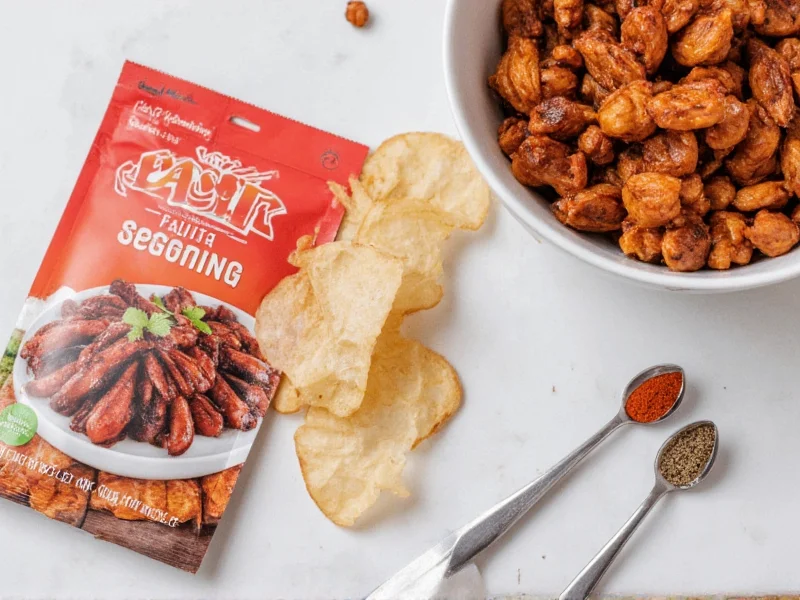Fajita seasoning packets offer convenient flavor solutions for busy home cooks, but knowing what's inside helps you make informed choices. These pre-mixed spice blends simplify meal preparation while delivering the characteristic Tex-Mex flavors associated with sizzling fajitas. Let's explore everything you need to know about these kitchen staples, including ingredient breakdowns, usage tips, and how to craft your own superior homemade alternatives.
Core Components of Fajita Seasoning Packets
Commercial fajita seasoning packets maintain consistent flavor profiles through standardized ingredient ratios. The essential components include:
- Chili powder (30-40%): Provides the foundational heat and earthy flavor
- Ground cumin (20-25%): Delivers warm, nutty undertones essential to Mexican cuisine
- Garlic powder (10-15%): Adds savory depth without fresh garlic's moisture
- Onion powder (8-12%): Contributes sweetness and complexity
- Paprika (5-10%): Offers mild sweetness and vibrant color
- Dried oregano (3-5%): Provides herbal notes characteristic of Southwestern cooking
- Salt (15-25%): Enhances flavor but significantly impacts sodium content
Understanding fajita seasoning packet ingredients helps you adjust recipes based on dietary needs or flavor preferences. Some commercial blends include anti-caking agents like silicon dioxide or citric acid for preservation, which health-conscious cooks might prefer to avoid.
Nutritional Considerations
When evaluating store-bought fajita seasoning packet nutrition facts, sodium content warrants particular attention. A typical packet (about 2 tablespoons) contains 200-400mg sodium, which represents 9-17% of the recommended daily limit. For those monitoring sodium intake, creating a low sodium fajita seasoning recipe at home provides complete control over salt content.
Most commercial blends contain minimal calories (5-15 per serving) and negligible fat content, making them suitable for various dietary approaches. However, some budget brands may include fillers like maltodextrin or cornstarch that affect texture and flavor intensity.
Effective Usage Techniques
Maximizing flavor from your fajita seasoning packet instructions requires proper technique. For optimal results:
- Marinate properly: Combine the seasoning with 2-3 tablespoons oil and 1-2 tablespoons lime juice before adding to proteins. This creates an emulsion that adheres better than dry application.
- Timing matters: For chicken or steak, marinate 30-60 minutes; for shrimp, 15-20 minutes to prevent texture degradation.
- Reserve some for finishing: Set aside 1 teaspoon of the dry mix to sprinkle on finished fajitas for brighter flavor.
- Adjust liquid content: When using with vegetables, add 2-3 tablespoons water to help distribute seasoning evenly during cooking.
Many home cooks make the mistake of applying seasoning directly to raw meat without oil or acid, resulting in uneven flavor distribution and spice burning during high-heat cooking.
Store-Bought vs. Homemade Comparison
| Feature | Store-Bought Packets | Homemade Blend |
|---|---|---|
| Cost per batch | $0.75-$1.50 | $0.25-$0.40 |
| Sodium control | Fixed amount | Adjustable to preference |
| Flavor customization | Standardized | Infinitely adjustable |
| Shelf life | 18-24 months | 3-6 months |
| Ingredient quality | Variable by brand | Controlled by you |
| Preparation time | Instant | 5 minutes |
Superior Homemade Fajita Seasoning Recipe
Creating your own homemade fajita seasoning recipe takes just minutes and yields noticeably better flavor than most commercial options. This versatile blend works for 1.5-2 pounds of protein:
Basic Homemade Blend
- 2 tablespoons chili powder
- 1 tablespoon ground cumin
- 1½ teaspoons garlic powder
- 1½ teaspoons onion powder
- 1 teaspoon smoked paprika
- 1 teaspoon dried oregano
- ½ teaspoon cayenne pepper (optional for heat)
- 1 teaspoon salt (adjust to taste)
- ½ teaspoon black pepper
Mix thoroughly in a small bowl, then store in an airtight container. This easy fajita seasoning from scratch eliminates unnecessary additives while allowing customization. For a restaurant-style fajita seasoning recipe, increase the cumin by ½ teaspoon and add ¼ teaspoon of coriander.
Common Mistakes to Avoid
Even experienced cooks make these fajita seasoning packet usage errors:
- Over-marinating delicate proteins: Shrimp and fish become mushy with extended acidic marinades
- Burning the spices: Adding dry seasoning directly to extremely hot pans causes bitterness
- Insufficient oil: Proper fat content carries flavor compounds and prevents sticking
- Skipping the acid component: Lime juice or vinegar brightens flavors and helps tenderize proteins
- Using expired spices: Ground spices lose potency after 6-12 months, resulting in flat flavor
For authentic results, remember that traditional fajitas use skirt steak cooked over high heat with minimal seasoning beyond salt, pepper, and lime. Modern fajita seasoning packet recipes evolved from this simple foundation to incorporate more complex spice blends.
Customizing Your Flavor Profile
One advantage of making your own custom fajita seasoning blend is tailoring to specific preferences:
- For smokier flavor: Replace regular paprika with chipotle powder (start with ½ teaspoon)
- For sweeter profile: Add ¼ teaspoon cinnamon or increase paprika to 1½ teaspoons
- For restaurant-style heat: Include ¼-½ teaspoon cayenne or crushed red pepper
- For citrus notes: Add ½ teaspoon dried orange peel or zest from one lime
- For depth: Include ¼ teaspoon cocoa powder (surprisingly authentic in Mexican cuisine)
When adjusting your homemade fajita seasoning proportions, modify one ingredient at a time and document changes to recreate successful variations.











 浙公网安备
33010002000092号
浙公网安备
33010002000092号 浙B2-20120091-4
浙B2-20120091-4